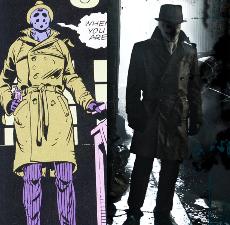“Watchmen,” Zach Snyder’s film adaptation of Alan Moore’s comic, sets a fine line between what an adaptation should be and what it shouldn’t.
“Watchmen” occurs in an alternate 1985, where masked vigilantes (a la Batman) have become an integral part of U.S. history. Because of this, America wins the Vietnam War, Watergate never occurs and Nixon is still president. However, the U.S. is still on the brink of nuclear holocaust with the Soviet Union.
The film revolves around six retired “superheroes”: Nite Owl II (Patrick Wilson), Rorschach (Jackie Earle Haley), Silk Spectre II (Malin Akerman), Ozymandias (Matthew Goode), The Comedian (Jeffrey Dean Morgan) and Dr. Manhattan (Billy Crudup). The story begins when one of them, The Comedian, is violently murdered.
The twist is these heroes are neither truly super nor heroes, and what they lack in special powers they more than make up for in character defects.
This film is, in a way, groundbreaking because of the attention to detail that Snyder gives in the adaptation. He obviously strays very little visually from the original comic.
Snyder used panels from the original comic, originally illustrated by Dave Gibbons, as storyboards for the scenes in the movie, and it shows.
The set designs and graphics create a world that looks exactly like Moore and Gibbon’s alternate 1985. Small inclusions, such as the old MTV logo and the 1984 Apple commercial add additional proof that this movie takes place when it says it does.
Not just the sets, but whole scenes play out exactly as they did in the original comic. The characters say the same words and the colors and backgrounds look the same. It’s in some parts like watching the comic.
And this is where Snyder gets himself into trouble. While the accuracy of the visual details greatly enhance this comic book adaptation, Snyder’s attempt to stay as similar to the source material as possible maybe the biggest detriment to the movie.
Excluding the ending, “Watchmen” is relatively unchanged in terms of story. What hurts the plot is Snyder’s choice of scenes to include and information to be cut.
Unfortunately, many of the small, seemingly unimportant bits of background info and supplemental material that Moore uses to create the comic’s alternate world are left out, which causes some scenes in the movie to lose importance or not make sense.
Even though the threat of nuclear extinction is a vital part of the story and is mentioned repeatedly in the movie, at no point does it ever feel that there is any real threat or actual danger.
Also the Keane Act, the fictional legislation that forces the heroes into retirement, is mentioned, but not really explained. Although not the most important aspect of the movie, this still hurts the overall flow of the story.
While trying to preserve the story’s accuracy, Snyder still ends up stumbling into continuity errors within his own movie.
In one scene, Silk Spectre II is teleported to visit her mom by Dr. Manhattan. At this point in the film, Dr. Manhattan’s ability to teleport has not been stated, and he is not viewed in this scene.
In addition, Dr. Manhattan’s ability to view the future is blurred by tachyons towards the beginning of the film. Later, Manhattan can see his future again. Then, towards the end, can’t again.
These errors aren’t big, but cumbersome, especially to viewers unfamiliar with comic.
Moore’s comic, rather than an action-packed superhero adventure, is a character piece analyzing the less flattering characteristics of a “superhero.” The main story of “Watchmen” isn’t as important as the back-stories and issues of the characters themselves.
Snyder, while trying to retain the accuracy of the main plot, cuts out crucial scenes exploring the masked vigilantes themselves, and in process, cuts out the core of what “Watchmen” is about.
While many of the issues each of the characters have are hinted at, they are never explored with much depth.
The omnipotent and blue Dr. Manhattan is supposed to have lost all connection with humanity. Yet this key aspect of this character is left relatively unexplored and often just stated in the dialogue of other characters.
What the audience gets is a marathon paced set of flashbacks that are supposed to explain Dr. Manhattan’s origins as Earth’s only real superhero, but these flashbacks are disjointed and very superficial.
The fact that Nite Owl’s impotency is only cured after he dons his superhero costume, a key element for that character, is shown, but in a way that makes the fact hard to comprehend.
The other characters are developed even worse with less time dedicated to their individual stories.
The one exception is Rorschach, who easily gets the most screen time and the best explanation for his origins. Still, a lot of the depictions of Rorschach’s purely black and white nature, and the hypocrisy that stems from it, are left out of this film.
Overall, “Watchmen” is a visually accurate adaptation and, compared to most superhero movies before the last couple of years, is solid. Unfortunately, while Snyder’s preoccupation with truthfulness to the comic helps the film visually, it helps the film miss the comic’s original intentions. The comic wasn’t supposed to tell a story, it was supposed to make a point. Snyder misses that point.

